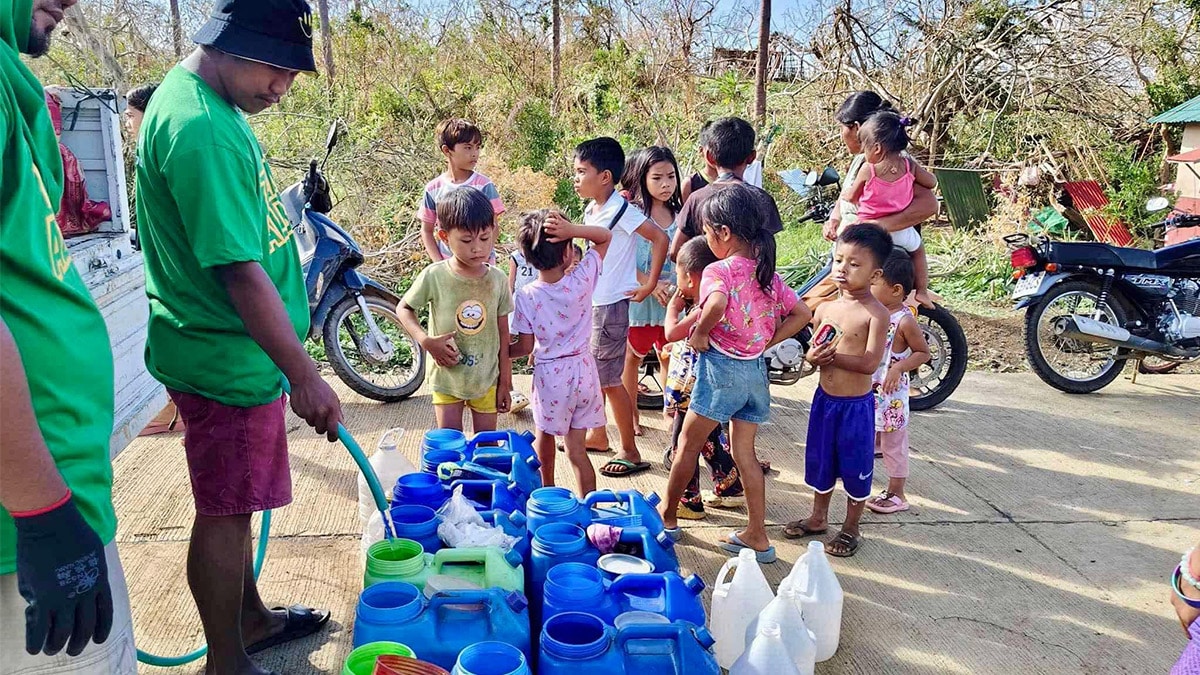
WATER LINE Children wait for their turn as a volunteer fills containers with drinking water provided by the water filtration machine brought by Team Albay in Pandan, Catanduanes, on Saturday, Nov. 23. —Mox Rubio Mendones/Contributor
LEGAZPI CITY, ALBAY, Philippines — Catanduanes province continuous to face the harsh effects of last week’s Super Typhoon Pepito (international name: Man-yi), with many localities still without electricity, houses need to be rebuilt, and damages to agriculture and infrastructure now at P1.93 billion.
Agriculture took most of the typhoon’s brunt, with damages initially reaching P1.3 billion, while infrastructure losses reached P631 million, according to Gov. Joseph Cua.
READ: DICT deploys equipment as Marcos rallies help for Catanduanes
Cua, in a phone interview Sunday, said the initial agriculture damage assessment included the destruction of abaca plantations, a key economic driver in the province.
“We are in the process of recovering, and the aid coming from the government and various sectors has a great impact on us,” Cua said.
While there are no longer any evacuees, 7,818 families who lost their homes still needed construction materials, he added.
“We are now procuring GI sheets (100,000 pieces) and other materials needed for rebuilding the houses, but it’s not enough. For those residents whose houses were partially damaged, they were given tarpaulins,” he said.
No power still
He said they were grateful that the assistance from the Department of Social Welfare and Development, and the Department of Labor and Employment continued to pour in, as directed by President Marcos.
Power still has not returned in most of Catanduanes since Pepito made landfall in the province’s Panganiban town at 9:40 p.m. on Nov. 16, and continued to dump more destructive winds in other parts of the island and later in northern Luzon from Nov. 17 to Nov. 18.
Cua said electric cooperatives from different provinces across the nation have sent teams to his province to help restore their downed power lines.
So far, only 64 of Catanduanes’ 315 barangays have electricity, Cua said.
Help from various sectors also continued to reach the province, including those from the provinces of Albay and Sorsogon, Catanduanes’ neighbors in the Bicol region, that brought food, building materials, medical teams and, in the case of Albay, a water filtration machine.
The Talino at Galing ng Pilipino (TGP) party list also came to the aid of the province, which distributed over 11,000 relief packages to the towns of Panganiban, Bagamanoc, Viga, San Miguel, Gigmoto, Bato, Baras, Caramoran, Pandan, San Andres and Virac on Friday.
“We will be providing them with their needs, especially for those who lost their livelihoods, particularly abaca farming, after Pepito struck the province,” TGP party list Rep. Jose Bong Teves Jr. said by phone on Sunday.
Clearing of roads, medical missions, and psychosocial activities are still ongoing in the province, he added.
Meanwhile, classes in public and private schools that were suspended since the typhoon struck will resume on Monday, according to Department of Education Bicol Director Gilbert Sadsad.
Classes will be held in schools and not in temporary learning spaces since evacuees have already vacated the school buildings, said Sadsad in a text message on Sunday.